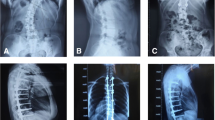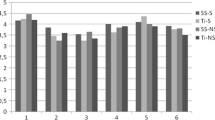Abstract
The expectations of both the patient and surgeon have been greatly revised in the last 10 years with the introduction of pedicle screws (PS) in spinal surgery. In this study, we have retrospectively evaluated and compared the results of PS instrumentation and the Hybrid System (HS), the latter consists of pedicle screws, sublaminar wire and hooks. The mean follow-up period was 60.1 months (range: 49–94 months) for the patients of the HS group and 29.3 months (range: 24–35 months) for those of the PS group. In the HS group, pedicle screws were used at the thoracolumbar junction and lumbar vertebra, the bilateral pediculotransverse claw hook configuration was used at the cranial end of the instrumentation, sublaminar wire was used on the concave side of the apical region and the compressive hook was used on the convex side. In the PS group, PS were used on the concave sides at all levels and on the convex side of the cranial and caudal end of instrumentation, in the transition zone and at the apex. The two groups were comparable for variables such as mean age, preoperative Cobb angle, thoracic kyphosis angle, lordosis angle, coronal balance, flexibility of the curve, apical vertebra rotation (AVR), apical vertebra rotation (AVT) and the number of vertebrae included in the fusion (p > 0.05). The parameters of values of correction, ratio of correction loss, AV derotation, AVT correction ratio, amount of blood loss, operation time, postoperative global coronal and sagittal balance, thoracic kyphosis angle and lumbar lordosis angle were measured at the last follow-up and used for comparing the HS and PS groups. There was no statistically significant difference between the groups for correction ratio, postoperative coronal balance, postoperative thoracic kyphosis and lumbar lordosis angle, operation time, amount of blood loss and number of fixation points (p > 0.05) The difference for the ratio of correction loss, AV derotation angle and the AVT correction ratio at the last follow-up visit and for the total follow-up period between the groups was found to be statistically significant (p < 0.05). Although it is possible to obtain a similar amount of correction by either instrumentation system, the loss of correction seems to be lower with the more rigid PS construction. The PS system also has a stronger effect on vertebral bodies, thereby providing better AV de-rotation. There was no significant difference (p > 0.05) between the groups in terms of correction rate, postoperative coronal and sagittal balance, operation time, blood loss and number of fixation points. This may indicate that anchor points are more important than the use – or not – of screws. Correction durability and AV de-rotation was better with PS instrumentation, while AVT was better corrected by HS instrumentation (p < 0.05). We propose that the reason for the better correction of AVT with HS instrumentation is the forceful translation offered by the sublaminar wire at the apical region, while the reason for the better correction durability of the PS instrumentation may be due to the fact that multiple pedicle screws which afford three-column control are better at maintaining the correction and preventing late deterioration.
Résumé
Dans la chirurgie rachidienne les attentes des patients et des chirurgiens se sont grandement modifiées depuis 10 ans, depuis l’introduction des vis pédiculaires (PS). Nous avons pour cette étude évalué de façon rétrospective et comparé les résultats de vis pédiculaires avec une instrumentation hybride (HS) utilisant à la fois des vis pédiculaires, des fils et des crochets sous laminaires. Matériel et méthode : le suivi moyen a été de 60.1 mois (49 – 94 mois) pour le groupe HS et de 29.3 mois (24 – 35 mois) pour le groupe PS. Dans le groupe HS, les vis pédiculaires ont été utilisées à la jonction dorsolombaire, thoracolombaire et au niveau lombaire avec un dispositif pédiculo transverse terminant le montage à la partie supérieure, les fils laminaires étant utilisés dans la partie concave et, dans la partie convexe avec un crochet en compression à la partie la plus apicale de la courbe. Dans le groupe vis pédiculaires, celles-ci ont été utilisées dans la partie concave à tous les niveaux et dans la partie convexe et caudale pour stabiliser l’instrumentation. Les groupes ont été très comparables en termes d’âges, d’angles de Cobb pré-opératoires, de cyphose thoracique, de lordose lombaire, de rotation et de souplesse de la courbe et de nombre de vertèbres inclus dans le montage (P > 0.05). Les valeurs de correction, de pertes de correction, de dérotation, de pertes sanguines, de temps opératoires, de cyphose thoracique et de lordose lombaire ont été mesurées à la dernière revue des patients en comparant les deux groupes HS et PS. Résultats : il n’y a pas de différences significatives entre ces deux groupes en ce qui concerne la correction post opératoire, la cyphose thoracique post opératoire, la lordose lombaire post opératoire, le temps opératoire, les pertes sanguines et le nombre de points de fixation du matériel (p > 0.05). Par contre, il existe une différence en ce qui concerne les pertes de correction et l’angle de rotation, il est possible d’obtenir une correction similaire avec chaque instrumentation. Les pertes de correction sont beaucoup moins importantes avec le système vis pédicullaires, plus rigides (PS) qui entraînent une meilleure rotation. En conclusion : pour le taux de correction post opératoire, le temps opératoire, les pertes sanguines, le nombre de points de fixation les deux groupes ne montrent pas de différences significatives (p > 0.05). Ceci nous indique que les points de fixation du matériel sont plus importants que l’utilisation de vis. La stabilité à long terme et la dérotation sont nettement améliorées avec l’instrumentation PS, l’AVT étant mieux corrigé avec l’instrumentation HS (p < 0.05). Nous pensons que pour avoir une meilleure correction de l’AVT comme réalisé avec l’instrumentation HS, il est nécessaire d’avoir une translation entraînée par les fils sous laminaires dans la région apicale. Par contre les raisons d’une meilleure correction et d’une meilleure stabilité dans le groupe PS sont secondaires aux multiples vis pédiculaires qui contrôlent beaucoup mieux les trois colonnes au niveau du montage avec une bonne stabilité empêchant une perte de correction secondaire.


Similar content being viewed by others
References
Aaro S, Dahlborn M (1981) Estimation of vertebral rotation and the spinal and rib cage deformity in scoliosis by computer tomography. Spine 6:460–467
Asher M, Lai SM, Burton D, Manna B, Cooper A (2004) Safety and efficacy of Isola instrumentation and arthrodesis for adolescent idiopathic scoliosis: two-to 12-year follow-up. Spine 29:2013–2023
Cheng I, Kim Y, Gupta MC, Bridwell KH, Hurford RK, Lee SS, Theerajunyaporn T, Lenke LG (2005) Apical sublaminar wires versus pedicle screws. Which provides better results for surgical correction of adolescent idiopathic scoliosis? Spine 30:2104–2112
Girardi FP, Boachie-Adjei O, Rawlins BA (2000) Safety of sublaminar wires with Isola instrumentation for the treatment of idiopathic scoliosis. Spine 25:691–695
Hall BB, Asher MA, Zang RH, Quinn LM (1996) The safety and efficacy of the Isola Spinal Implant System for the surgical treatment of degenerative disc disease. A prospective study. Spine 21:982–994
Halm H, Niemeyer T, Link T, Liljenqvist U (2000) Segmental pedicle screw instrumentation in idiopathic thoracolumbar and lumbar scoliosis. Eur Spine J 9:191–197
Kim YJ, Lenke LG, Cho SK, Bridwell KH, Sides B, Blanke K (2004) Comparative analysis of pedicle screw versus hook instrumentation in posterior spinal fusion of adolescent idiopathic scoliosis. Spine 29:2040–2048
Lenke LG, Kim Y, Rinella A (2002) Treatment of spinal deformity utilizing thoracic pedicle screws. Seminar Spine Surg 14:66–87
Leung JP, Lam TP, Ng BK, Cheng JC (2002) Posterior ISOLA segmental spinal system in the treatment of scoliosis. J Pediatr Orthop 22:296–301
Liljenqvist UR, Halm HF, Link TM (1997) Pedicle screw instrumentation of the thoracic spine in idiopathic scoliosis. Spine 22:2239–2245
Liljenqvist U, Lepsien U, Hackenberg L, Niemeyer T, Halm H (2002) Comparative analysis of pedicle screw and hook instrumentation in posterior correction and fusion of idiopathic thoracic scoliosis. Eur Spine J 11:336–343
Luque ER (1982) Segmental spinal instrumentation for correction of scoliosis. Clin Orthop Relat Res 163:192–198
Min K, Waelchli B, Hahn F (2005) Primary thoracoplasty and pedicle screw instrumentation in thoracic idiopathic scoliosis. Eur Spine J 14:777–782
Storer SK, Vitale MG, Hyman JE, Lee FY, Choe JC, Roye DP Jr (2005) Correction of adolescent idiopathic scoliosis using thoracic pedicle screw fixation versus hook constructs. J Pediatr Orthop 25:415–419
Suk SI, Lee CK, Kim WJ, Chung YJ, Park YB (1995) Segmental pedicle screw fixation in the treatment of thoracic idiopathic scoliosis. Spine 20:1399–1405
Suk SI, Kim WJ, Kim JH, Lee SM (1999) Restoration of thoracic kyphosis in the hypokyphotic spine: a comparison between multiple-hook and segmental pedicle screw fixation in adolescent idiopathic scoliosis. J Spinal Disord 12:489–495
Suk SI, Kim WJ, Lee SM, Kim JH, Chung ER (2001) Thoracic pedicle screw fixation in spinal deformities: are they really safe? Spine 26:2049–2057
Yongjung JK, Lenke LG, Kim J, Bridwell KH, SK Cho, Cheh G, Sides B (2006) Comparative analysis of pedicle screw versus hybrid instrumentation in posterior spinal fusion of adolescent idiopathic scoliosis. Spine 31:291–298
Author information
Authors and Affiliations
Corresponding author
Rights and permissions
About this article
Cite this article
Karatoprak, O., Unay, K., Tezer, M. et al. Comparative analysis of pedicle screw versus hybrid instrumentation in adolescent idiopathic scoliosis surgery. International Orthopaedics (SICO 32, 523–528 (2008). https://doi.org/10.1007/s00264-007-0359-0
Received:
Revised:
Accepted:
Published:
Issue Date:
DOI: https://doi.org/10.1007/s00264-007-0359-0




